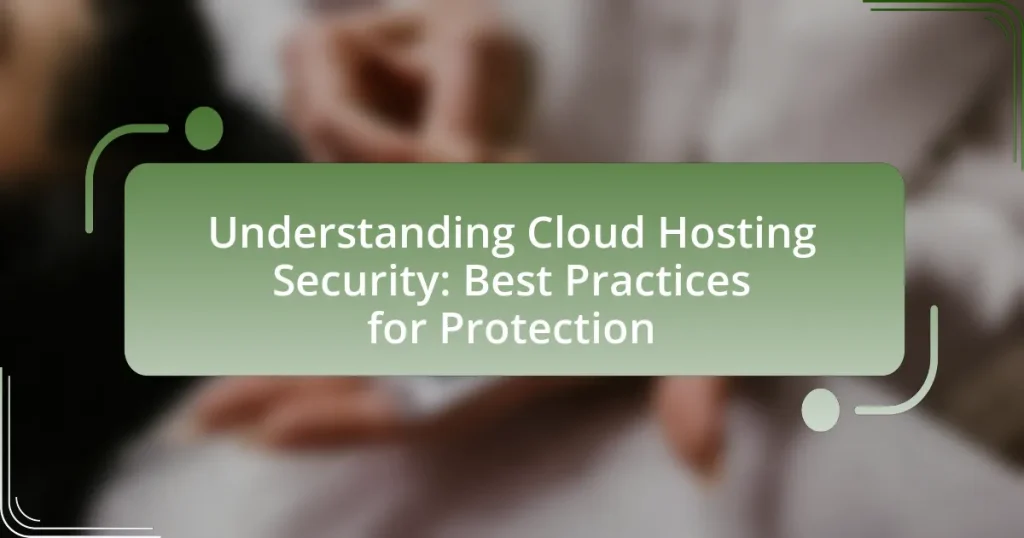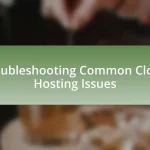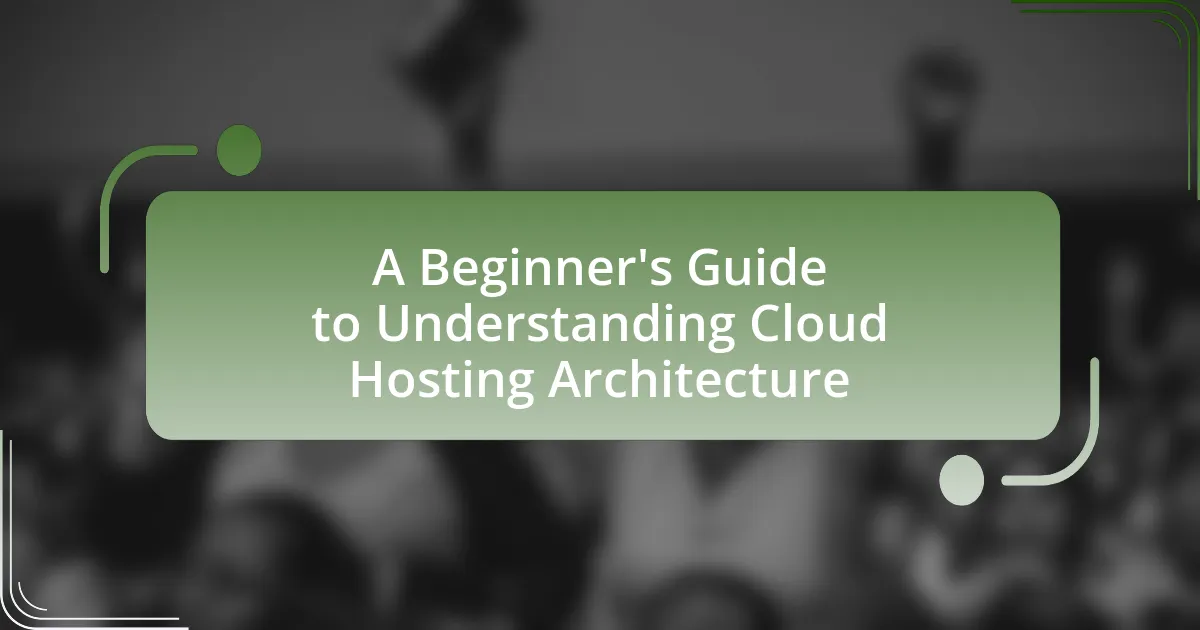Cloud hosting security encompasses the measures and protocols designed to protect data, applications, and services within a cloud environment, addressing threats such as data breaches and unauthorized access. The article explores the differences between cloud hosting security and traditional hosting security, highlighting the unique challenges posed by shared resources and compliance requirements. It emphasizes the importance of implementing best practices, including strong access controls, encryption, and regular security audits, to mitigate risks and enhance overall security. Additionally, the article discusses common threats to cloud environments, the impact of security breaches on business operations, and the regulatory considerations organizations must navigate to ensure robust cloud security.
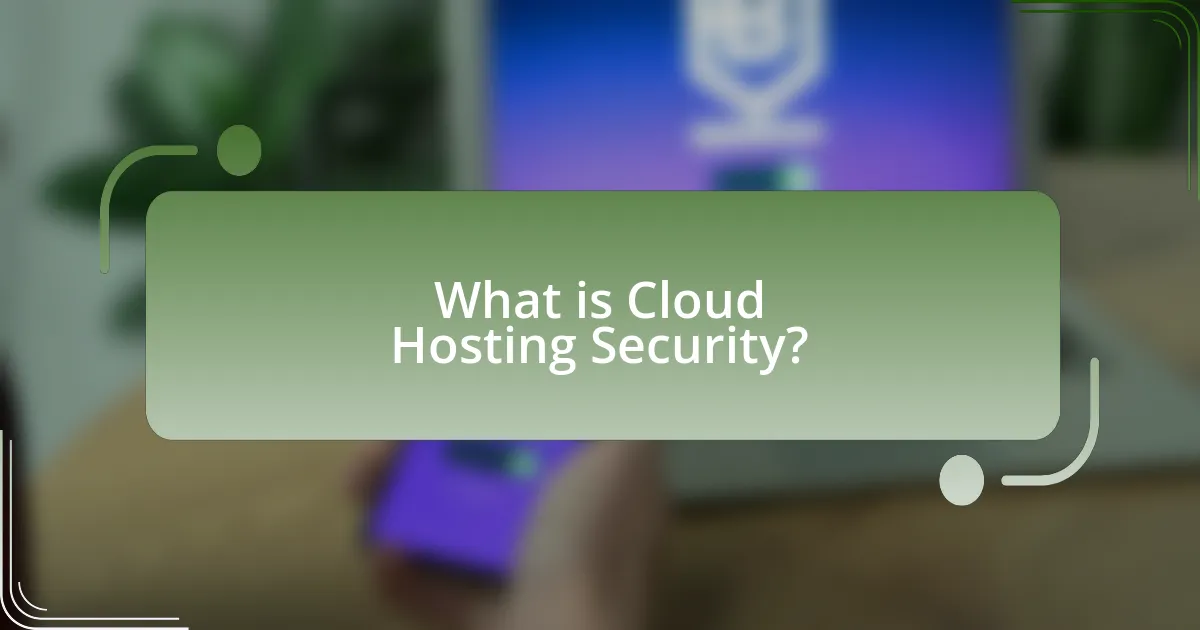
What is Cloud Hosting Security?
Cloud hosting security refers to the measures and protocols implemented to protect data, applications, and services hosted in a cloud environment. This security encompasses various aspects, including data encryption, access controls, and regular security audits, to safeguard against unauthorized access, data breaches, and other cyber threats. According to a report by McAfee, 52% of organizations experienced a cloud security incident in the past year, highlighting the critical need for robust security practices in cloud hosting.
How does Cloud Hosting Security differ from traditional hosting security?
Cloud hosting security differs from traditional hosting security primarily in its scalability and shared resources. In cloud hosting, security measures are often integrated at multiple levels across a distributed network, allowing for real-time updates and adaptive responses to threats. Traditional hosting typically relies on a single server or a limited infrastructure, which can create vulnerabilities if not properly maintained. For instance, cloud providers often implement advanced security protocols such as encryption, multi-factor authentication, and continuous monitoring, which are less common in traditional hosting environments. This multi-layered approach in cloud hosting enhances overall security, as evidenced by the fact that cloud providers frequently undergo rigorous compliance certifications, such as ISO 27001, to ensure robust security practices.
What are the unique challenges of securing cloud environments?
Securing cloud environments presents unique challenges primarily due to shared responsibility models, data privacy concerns, and the dynamic nature of cloud resources. The shared responsibility model means that while cloud service providers manage the security of the cloud infrastructure, customers are responsible for securing their data and applications, leading to potential gaps in security if not properly understood. Data privacy concerns arise from the storage of sensitive information across multiple jurisdictions, which can complicate compliance with regulations like GDPR. Additionally, the dynamic nature of cloud resources, including rapid scaling and frequent changes, increases the risk of misconfigurations and vulnerabilities, as evidenced by reports indicating that 70% of cloud security failures are attributed to misconfigurations.
How do shared resources impact security in cloud hosting?
Shared resources in cloud hosting can significantly impact security by increasing the risk of data breaches and unauthorized access. When multiple clients utilize the same physical infrastructure, vulnerabilities in one tenant’s environment can potentially be exploited to access another tenant’s data. For instance, a study by the Cloud Security Alliance indicates that 60% of organizations have experienced a security incident related to shared resources in cloud environments. This highlights the importance of implementing strong isolation measures, such as virtual private clouds and robust access controls, to mitigate these risks and protect sensitive information.
Why is Cloud Hosting Security important for businesses?
Cloud Hosting Security is crucial for businesses because it protects sensitive data from breaches and cyberattacks. With the increasing reliance on cloud services, businesses face heightened risks of data loss, unauthorized access, and compliance violations. According to a report by McAfee, 21% of organizations experienced a cloud-related security incident in the past year, highlighting the need for robust security measures. Effective cloud security safeguards customer information, maintains business continuity, and ensures compliance with regulations, ultimately preserving a company’s reputation and trust.
What are the potential risks of inadequate cloud security?
Inadequate cloud security poses significant risks, including data breaches, loss of sensitive information, and unauthorized access to systems. These risks can lead to financial losses, reputational damage, and legal consequences for organizations. For instance, a 2020 report by IBM found that the average cost of a data breach was $3.86 million, highlighting the financial impact of inadequate security measures. Additionally, the 2021 Verizon Data Breach Investigations Report indicated that 61% of breaches involved cloud assets, underscoring the vulnerability of cloud environments.
How can security breaches affect business operations and reputation?
Security breaches can severely disrupt business operations and damage reputation. When a breach occurs, immediate operational impacts include downtime, loss of access to critical data, and potential financial losses due to remediation efforts. For instance, the 2017 Equifax breach, which exposed sensitive information of 147 million people, resulted in a significant operational overhaul and costs exceeding $4 billion.
Additionally, the reputational damage from a security breach can lead to loss of customer trust, decreased sales, and long-term brand harm. A study by IBM found that 77% of consumers would not engage with a company that had experienced a data breach. This illustrates how security breaches not only affect immediate operations but also have lasting effects on a company’s standing in the market.
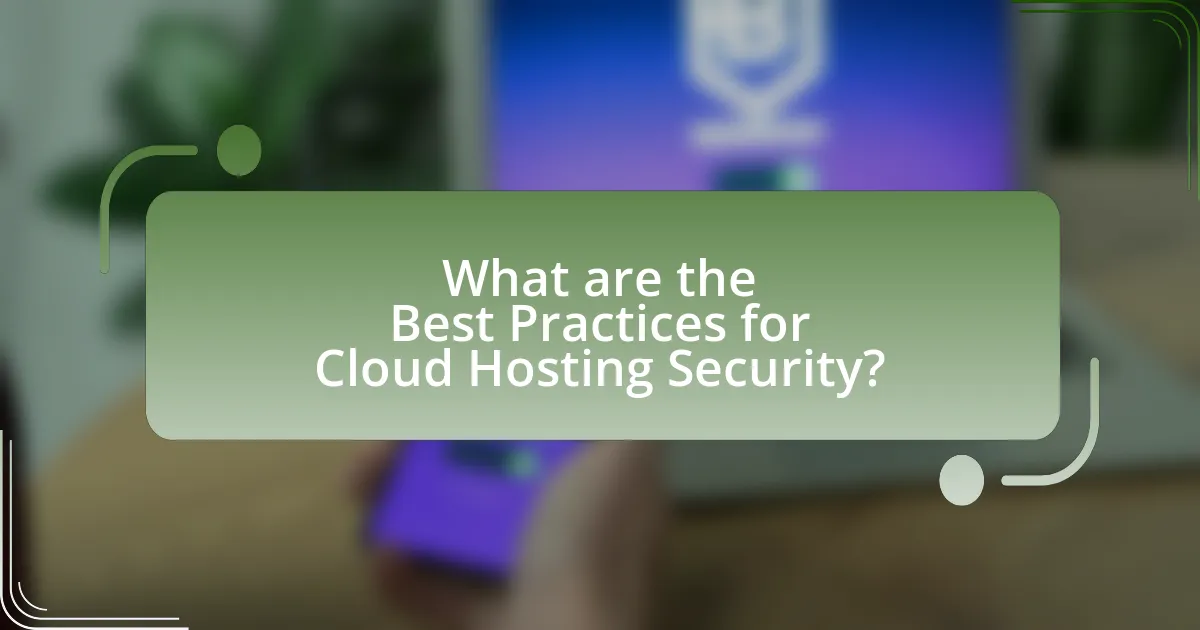
What are the Best Practices for Cloud Hosting Security?
The best practices for cloud hosting security include implementing strong access controls, utilizing encryption, regularly updating and patching systems, and conducting regular security audits. Strong access controls, such as multi-factor authentication, ensure that only authorized users can access sensitive data. Encryption protects data both at rest and in transit, making it unreadable to unauthorized parties. Regular updates and patches address vulnerabilities, reducing the risk of exploitation. Security audits help identify weaknesses in the system and ensure compliance with security standards. These practices collectively enhance the security posture of cloud hosting environments, as evidenced by industry reports indicating that organizations employing these measures experience significantly fewer security breaches.
How can organizations implement strong access controls?
Organizations can implement strong access controls by adopting a multi-layered approach that includes role-based access control (RBAC), strong authentication mechanisms, and regular audits. RBAC ensures that users have access only to the information necessary for their roles, minimizing the risk of unauthorized access. Strong authentication mechanisms, such as multi-factor authentication (MFA), add an additional layer of security by requiring users to provide multiple forms of verification before gaining access. Regular audits help organizations identify and rectify any access control weaknesses, ensuring compliance with security policies and standards. According to a study by the Ponemon Institute, organizations that implement RBAC and MFA significantly reduce the likelihood of data breaches, demonstrating the effectiveness of these access control strategies.
What role do identity and access management systems play?
Identity and access management (IAM) systems play a crucial role in securing cloud environments by controlling user access to resources. IAM systems authenticate and authorize users, ensuring that only legitimate users can access sensitive data and applications. According to a report by Gartner, organizations that implement IAM solutions can reduce security breaches by up to 80%, highlighting their effectiveness in protecting cloud-hosted assets. IAM systems also facilitate compliance with regulations by providing audit trails and access controls, which are essential for maintaining security standards in cloud hosting.
How can multi-factor authentication enhance security?
Multi-factor authentication (MFA) enhances security by requiring users to provide multiple forms of verification before gaining access to an account. This additional layer of security significantly reduces the risk of unauthorized access, as it is unlikely that an attacker would possess all required factors, which typically include something the user knows (like a password), something the user has (like a smartphone or hardware token), and something the user is (like a fingerprint). According to a study by the Cybersecurity & Infrastructure Security Agency, implementing MFA can block over 99% of automated attacks, demonstrating its effectiveness in protecting sensitive information and systems from breaches.
What encryption methods should be used for data protection?
For data protection, symmetric encryption methods such as Advanced Encryption Standard (AES) and asymmetric encryption methods like RSA should be used. AES is widely recognized for its efficiency and security, utilizing key sizes of 128, 192, or 256 bits, making it suitable for encrypting large volumes of data. RSA, on the other hand, is commonly used for secure key exchange and digital signatures, relying on the mathematical difficulty of factoring large prime numbers. Both methods are endorsed by organizations such as the National Institute of Standards and Technology (NIST), which recommends AES as a standard for federal use.
How does encryption at rest differ from encryption in transit?
Encryption at rest protects data stored on physical devices, while encryption in transit secures data as it travels across networks. Encryption at rest ensures that data is unreadable when stored, using methods like AES (Advanced Encryption Standard) to safeguard sensitive information on hard drives or cloud storage. In contrast, encryption in transit employs protocols such as TLS (Transport Layer Security) to protect data from interception during transmission between servers and clients. Both methods are essential for comprehensive data security, addressing different vulnerabilities in the data lifecycle.
What are the best practices for managing encryption keys?
The best practices for managing encryption keys include implementing a robust key management system, regularly rotating keys, and ensuring keys are stored securely. A key management system centralizes the generation, storage, and distribution of keys, reducing the risk of unauthorized access. Regular key rotation minimizes the impact of a compromised key, as it limits the time an attacker can exploit it. Secure storage methods, such as hardware security modules (HSMs) or cloud-based key management services, protect keys from unauthorized access and physical theft. According to the National Institute of Standards and Technology (NIST), following these practices significantly enhances the security of cryptographic systems and reduces vulnerabilities associated with key management.
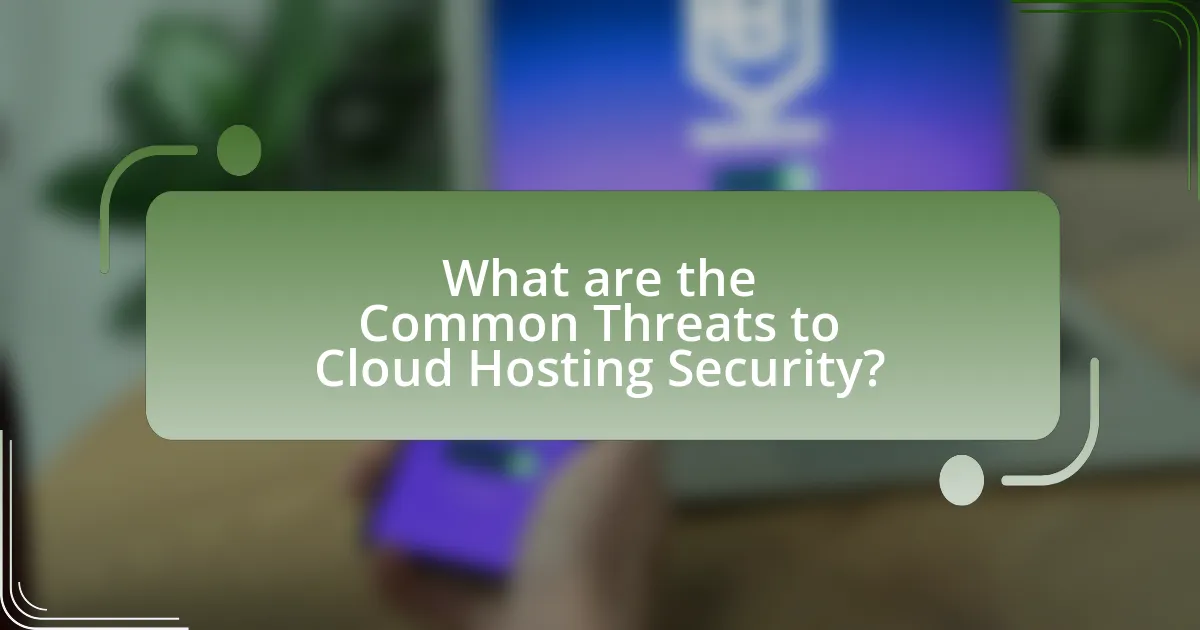
What are the Common Threats to Cloud Hosting Security?
Common threats to cloud hosting security include data breaches, account hijacking, insecure APIs, and insider threats. Data breaches occur when unauthorized individuals gain access to sensitive information stored in the cloud, often due to weak security measures or vulnerabilities in the cloud infrastructure. Account hijacking involves attackers taking control of user accounts, typically through phishing or credential theft, leading to unauthorized access to cloud resources. Insecure APIs can expose cloud services to attacks if not properly secured, allowing malicious actors to exploit vulnerabilities. Insider threats arise from employees or contractors who misuse their access to cloud resources, either intentionally or unintentionally, leading to data loss or security incidents. According to the 2021 Cloud Security Report by Cybersecurity Insiders, 93% of organizations experienced a cloud security incident in the past year, highlighting the prevalence of these threats.
What types of cyberattacks target cloud environments?
Cyberattacks targeting cloud environments include data breaches, denial-of-service (DoS) attacks, account hijacking, insecure APIs, and insider threats. Data breaches occur when unauthorized individuals access sensitive information stored in the cloud, often exploiting vulnerabilities in security protocols. Denial-of-service attacks aim to overwhelm cloud services, rendering them unavailable to legitimate users, which can disrupt business operations. Account hijacking involves attackers gaining unauthorized access to user accounts, often through phishing or credential theft, leading to unauthorized actions within the cloud environment. Insecure APIs can expose cloud services to vulnerabilities, allowing attackers to manipulate or extract data. Insider threats arise from employees or contractors misusing their access to cloud resources, either maliciously or inadvertently, which can compromise security. These attack types highlight the importance of robust security measures in cloud environments.
How do DDoS attacks affect cloud services?
DDoS attacks significantly disrupt cloud services by overwhelming them with excessive traffic, rendering them inaccessible to legitimate users. This influx of malicious requests can lead to service outages, degraded performance, and increased latency. For instance, a report from the cybersecurity firm Akamai noted that DDoS attacks have increased in frequency and scale, with some attacks exceeding 1.3 terabits per second, which can incapacitate cloud infrastructure. Consequently, businesses relying on cloud services may experience financial losses, damage to reputation, and potential data breaches due to the vulnerabilities exposed during such attacks.
What is the impact of insider threats on cloud security?
Insider threats significantly undermine cloud security by facilitating unauthorized access to sensitive data and systems. These threats can originate from employees, contractors, or business partners who exploit their legitimate access for malicious purposes, leading to data breaches, financial loss, and reputational damage. According to a report by the Ponemon Institute, 60% of organizations experienced an insider attack in the past year, highlighting the prevalence and impact of such threats. Furthermore, the average cost of an insider-related incident is estimated to be $11.45 million, underscoring the financial ramifications of these security breaches.
How can organizations detect and respond to security incidents?
Organizations can detect and respond to security incidents by implementing a combination of monitoring tools, incident response plans, and employee training. Continuous monitoring through security information and event management (SIEM) systems allows organizations to identify anomalies and potential threats in real-time. For instance, a study by the Ponemon Institute found that organizations using SIEM solutions can reduce the time to detect breaches by 27%.
Once a potential incident is detected, a predefined incident response plan should be activated, which includes steps for containment, eradication, and recovery. This plan should be regularly tested and updated to adapt to evolving threats. Additionally, training employees on recognizing phishing attempts and other security threats enhances the organization’s overall security posture, as human error is a significant factor in many security incidents.
By combining these strategies, organizations can effectively detect and respond to security incidents, minimizing potential damage and ensuring a swift recovery.
What tools are available for monitoring cloud security?
Tools available for monitoring cloud security include AWS CloudTrail, Azure Security Center, Google Cloud Security Command Center, and third-party solutions like Splunk and Datadog. AWS CloudTrail provides detailed logs of API calls, enabling users to track changes and access patterns. Azure Security Center offers security management and threat protection across Azure resources. Google Cloud Security Command Center helps identify vulnerabilities and misconfigurations in Google Cloud environments. Third-party tools like Splunk and Datadog enhance visibility and analytics across multi-cloud environments, allowing for comprehensive security monitoring. These tools are widely recognized in the industry for their effectiveness in enhancing cloud security.
How can incident response plans be effectively implemented?
Incident response plans can be effectively implemented by establishing clear procedures, assigning roles, and conducting regular training and simulations. Organizations should define specific steps for detection, analysis, containment, eradication, and recovery from incidents. Assigning roles ensures accountability and clarity during an incident response. Regular training and simulations help teams practice their response and refine their processes, which is supported by research indicating that organizations with well-practiced incident response plans can reduce the average time to detect and respond to incidents by up to 50%.
What are the regulatory considerations for Cloud Hosting Security?
Regulatory considerations for Cloud Hosting Security include compliance with data protection laws, industry standards, and contractual obligations. Organizations must adhere to regulations such as the General Data Protection Regulation (GDPR) in Europe, which mandates strict data handling and privacy practices, and the Health Insurance Portability and Accountability Act (HIPAA) in the United States, which governs the protection of health information. Additionally, frameworks like the National Institute of Standards and Technology (NIST) Cybersecurity Framework provide guidelines for managing cybersecurity risks. Compliance with these regulations ensures that cloud service providers implement necessary security measures, conduct regular audits, and maintain transparency in data management practices, thereby safeguarding sensitive information and minimizing legal liabilities.
How do compliance requirements vary by industry?
Compliance requirements vary significantly by industry due to differing regulatory frameworks and operational risks. For example, the healthcare industry must adhere to the Health Insurance Portability and Accountability Act (HIPAA), which mandates strict data privacy and security measures to protect patient information. In contrast, the financial sector is governed by regulations such as the Sarbanes-Oxley Act, which focuses on financial reporting and corporate governance. Additionally, industries like manufacturing may be subject to environmental regulations, while technology firms often face data protection laws like the General Data Protection Regulation (GDPR) in Europe. These variations reflect the unique challenges and legal obligations each industry faces, necessitating tailored compliance strategies.
What are the implications of data residency laws on cloud security?
Data residency laws significantly impact cloud security by mandating that data be stored and processed within specific geographical boundaries. These regulations can lead to increased compliance requirements for cloud service providers, necessitating enhanced security measures to protect data from unauthorized access and breaches. For instance, the General Data Protection Regulation (GDPR) in Europe imposes strict guidelines on data handling, which can compel organizations to implement robust encryption and access controls to ensure compliance. Additionally, data residency laws may limit the availability of certain cloud services, as providers must establish data centers in multiple locations to meet local regulations, potentially increasing the attack surface and complicating security management.
What practical steps can organizations take to enhance Cloud Hosting Security?
Organizations can enhance Cloud Hosting Security by implementing multi-factor authentication (MFA) for all user accounts. MFA significantly reduces the risk of unauthorized access, as it requires users to provide two or more verification factors to gain access to their accounts. According to a report by Microsoft, enabling MFA can block 99.9% of account compromise attacks.
Additionally, organizations should regularly update and patch their cloud infrastructure to protect against vulnerabilities. The National Institute of Standards and Technology (NIST) emphasizes that timely updates are crucial for maintaining security and mitigating risks associated with known vulnerabilities.
Furthermore, conducting regular security audits and assessments helps identify potential weaknesses in the cloud environment. The Cloud Security Alliance recommends periodic assessments to ensure compliance with security policies and to adapt to evolving threats.
Lastly, organizations should encrypt sensitive data both in transit and at rest. The International Organization for Standardization (ISO) states that encryption is a fundamental security measure that protects data from unauthorized access and breaches.
